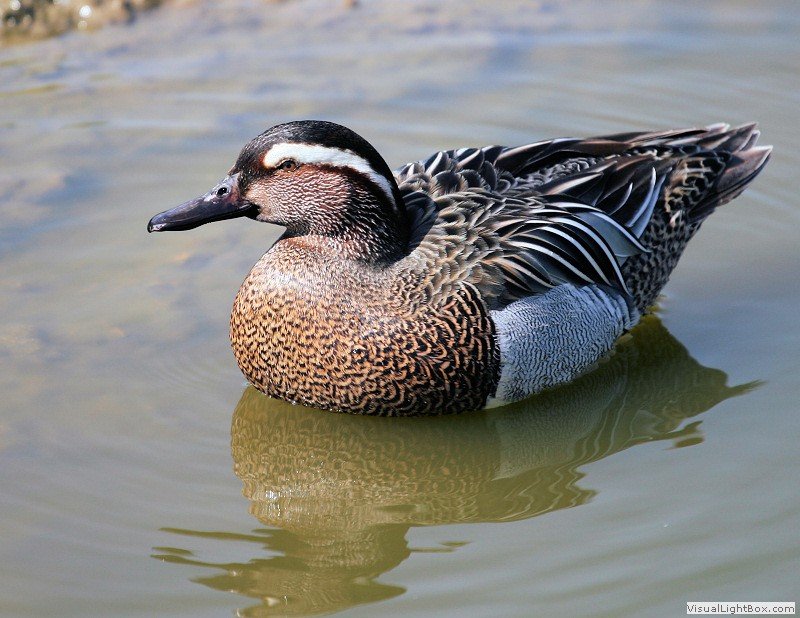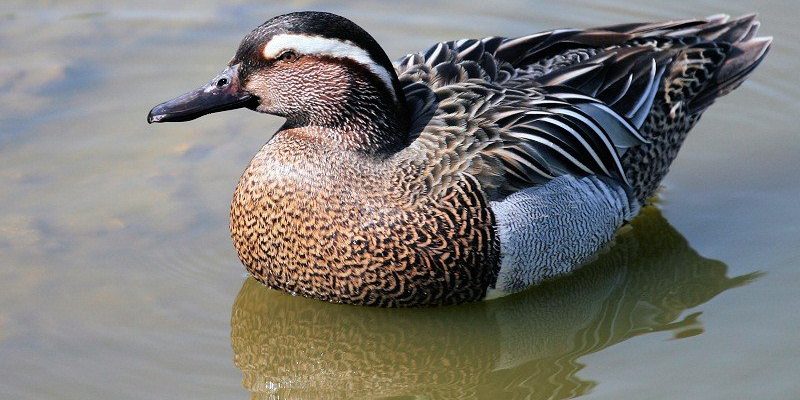
Imagine a bird that travels thousands of miles just to enjoy the warm sun of spring! That’s the Garganey for you—a small, elegant duck known for its impressive migrations. With its striking plumage, the Garganey isn’t just another face in the crowd; it stands out with a unique combination of beauty and grace. This fascinating bird alternates between breeding grounds in Europe and Africa, showcasing a life steeped in adventure.
But there’s more to the Garganey than just its charming appearance. From its hunting habits to its busy life cycle, these ducks have behaviors that tell stories of survival and adaptation. If you’re curious about how this bird lives, where it thrives, and what makes it tick, you’re in the right place. Let’s dive into the world of the Garganey and uncover all its secrets!
Physical Characteristics
The Garganey is a small to medium-sized dabbling duck, typically measuring around 14–16 inches in length. What makes it visually captivating is its unique color palette. The males sport a rich combination of chestnut-brown and white, often adorned with a striking blue-grey head and a distinctive white stripe across the eye. In contrast, the females, who are crucial during breeding, have mottled brown feathers that help them blend into their surroundings—an important feature for nesting and raising their young.
When they’re in flight, the Garganey showcases a formidable wing structure, with long and pointed wings that enable swift takeoffs and dynamic aerial maneuvers. Their body shape, coupled with their elegant necks, allows them easily navigate through various environments, from serene ponds to bustling wetlands. You might even catch a glimpse of them during their fearless dives, as they hunt underwater for their favorite foods.
In terms of size, the Garganey has a wingspan of about 26–30 inches, making it one of the more agile ducks in the water. This aerodynamic feature is essential for their migratory lifestyle, allowing them to cover vast distances without expending excessive energy. The combination of their eye-catching features and efficient build makes them one of the most interesting ducks to observe.
Habitat and Distribution
Garganeys are true wanderers, found primarily in marshy and wetland areas across Europe and parts of Western Asia. During the breeding season, these ducks prefer shallow freshwater lakes and ponds, as they provide both the food and cover needed for nesting. You might find them dabbling in these waters, tipping forward to forage for aquatic plants, small crustaceans, and insects.
During migration, the Garganey takes a long journey across the Mediterranean, often settling in temporary wetland stopovers to rest and feed. Their migratory route is fascinating—these birds have been known to travel from breeding grounds in Northern Europe to winter habitats in Africa, including regions like Senegal and Mali. Just think about that for a moment; they traverse over a thousand miles, showcasing resilience and adaptability to different climates and conditions.
The actual breeding grounds are typically chosen based on the availability of dense vegetation and water sources. Here, the female Garganey will construct a nest lined with down feathers, hidden among tall grasses or reeds to protect their eggs from predators. These carefully chosen locations ensure a higher survival rate for their young, highlighting the significant connection between their habitat choices and reproductive success.
Diet and Feeding Habits
Garganeys are primarily herbivores, but they have a diverse diet that includes a variety of aquatic plants, seeds, and small invertebrates. Their feeding strategy is fascinating; they are known to tip-forward, exposing their tails, to reach the food beneath the water’s surface. This technique is not just effective but also quite graceful, like a ballet performed on water.
During the breeding season, their diet shifts slightly to include more protein-rich foods. This change is essential for providing the energy the female needs while laying eggs, as well as for the growing ducklings. They’re known to forage on seeds from duckweed and other aquatic plants, and you’ll often see them foraging in the early morning or late evening, taking advantage of cooler temperatures.
You might wonder how their diet affects their behavior. Well, the seasonal changes dictate their feeding habits significantly. In winter, when food sources in their African habitats may dwindle, they adapt by seeking out more diverse foods, which often leads them to explore new areas. This kind of adaptability is crucial for survival, allowing them to thrive in various environments throughout the year.
Breeding and Nesting
The breeding season for the Garganey typically starts around late March to early April, depending on their location. During this time, the males display vibrant plumage and engage in elaborate courtship rituals to attract females. They perform a series of displays, including head bobbing and calling, to show off their vigor and appeal. It’s like a charming dance that captivates potential mates!
Once paired, the female will find a suitable nesting site, usually on the ground, well-hidden among dense vegetation near water bodies. She’ll lay around 8 to 12 eggs, which she incubates alone for about 25 days. After hatching, the ducklings are precocial, meaning they are relatively mature and mobile shortly after birth. They can swim and forage for food almost immediately, helping them to stay safe from predators.
One interesting aspect of Garganey breeding is their relatively low nest fidelity. Unlike some birds that return to the same nesting site year after year, Garganeys may choose different locations based on environmental conditions. This behavior showcases their adaptability and cleverness, as they find the best spots for raising their young each season.
Migration Patterns
Every year, the Garganey undertakes one of the most impressive migrations in the bird world. After breeding in Europe, they embark on a remarkable journey to their wintering grounds in Africa. This migration can span thousands of miles, and the timing usually correlates with seasonal weather changes. You might think of it like a grand adventure where they navigate through various landscapes and climates.
The migration route of the Garganey largely depends on environmental conditions, but they commonly fly over the Mediterranean Sea. This journey requires stamina and keen navigation skills, enabling them to find stopovers with ample food and shelter along the way. During migration, groups of Garganey often gather for safety, flying in V-shaped formations, which helps conserve energy and increase their efficiency.
Understanding their migration patterns is crucial for conservation efforts. Changes in climate and habitat destruction can significantly impact their migratory routes and success. By studying these patterns, researchers can work to protect vital wetland habitats that serve as resting or breeding sites for these incredible birds.
Conservation Status
While the Garganey is not currently considered endangered, it faces numerous threats that could impact its population in the future. Habitat loss due to urban development, agriculture, and climate change plays a significant role in their declining numbers. Wetlands are critical for their survival, and as these areas disappear, so do the natural resources that support the Garganey’s lifestyle.
Several conservation initiatives are in place to protect both the wetland habitats and the Garganey itself. These efforts include habitat restoration projects, the establishment of protected areas, and monitoring of populations. Engaging local communities in conservation efforts has also proven effective in protecting these areas, as people become aware of the ecological importance of sustaining bird populations.
Another important aspect of conservation is awareness. Educating the public about the challenges faced by the Garganey can inspire action and foster a sense of responsibility toward preserving these natural habitats. By working together, we can provide a safer environment for these migratory marvels and ensure they continue to grace our skies for generations to come.
Interesting Facts about Garganeys
| Scientific Name: | Anas querquedula |
| Average Size: | 14–16 inches (35–41 cm) |
| Wingspan: | 26–30 inches (66–76 cm) |
| Average Lifespan: | 5–10 years in the wild |
| Diet: | Aquatic plants, seeds, insects |
| Migration Distance: | Up to 2,000 miles (3,200 km) |
| Breeding Season: | March to April |
FAQ
What does a Garganey look like?
The Garganey is known for its striking appearance. Males have a distinctive blue-grey head and a white stripe over the eye, along with a chestnut-brown body. Females are more muted in color, featuring mottled browns that help them camouflage while nesting. This color variation plays a crucial role in their survival, especially during the breeding season.
Where do Garganeys migrate?
Garganeys migrate from their breeding grounds in Europe to wintering habitats in Africa, often traversing the Mediterranean Sea. This journey can be quite long, sometimes exceeding 2,000 miles, as they seek warmer climates during the colder months. They pause at various wetland stopovers along the route to rest and feed, demonstrating their resilience and adaptability.
How do Garganeys find food?
Garganeys are dabbling ducks, which means they feed by tipping forward in the water to access submerged plants and small creatures. They primarily eat aquatic vegetation, but their diet can include seeds and insects, especially during breeding season when they need more protein for their young. This feeding strategy allows them to thrive in various wetland environments.
Are Garganeys social birds?
Yes, Garganeys are quite social, often seen in small groups or flocks during migration and feeding. They exhibit social behaviors that help them stay safe from predators and enhance their foraging efficiency. Their social dynamics are an essential part of their survival strategy during different life stages.
What is the breeding behavior of Garganeys?
During the breeding season, male Garganeys engage in elaborate courtship displays to attract females. Once paired, the female selects a concealed nesting site near water, where she lays 8 to 12 eggs. The nest is well-hidden, providing protection from predators. After hatching, the ducklings can swim and feed almost immediately, showcasing their precocial nature.
How can we help Garganey conservation efforts?
Supporting Garganey conservation can involve various actions, including promoting awareness about wetland preservation, participating in local conservation programs, and advocating for sustainable practices. You can also help by supporting policies aimed at protecting natural habitats, which are crucial for their survival. Every little effort counts!
Are Garganeys endangered?
Currently, Garganeys are not classified as endangered, but they face threats from habitat loss and climate change. As wetlands continue to disappear, their populations could decline. Ongoing conservation efforts are vital to ensuring that these magnificent birds have a chance to thrive in their natural habitats.

